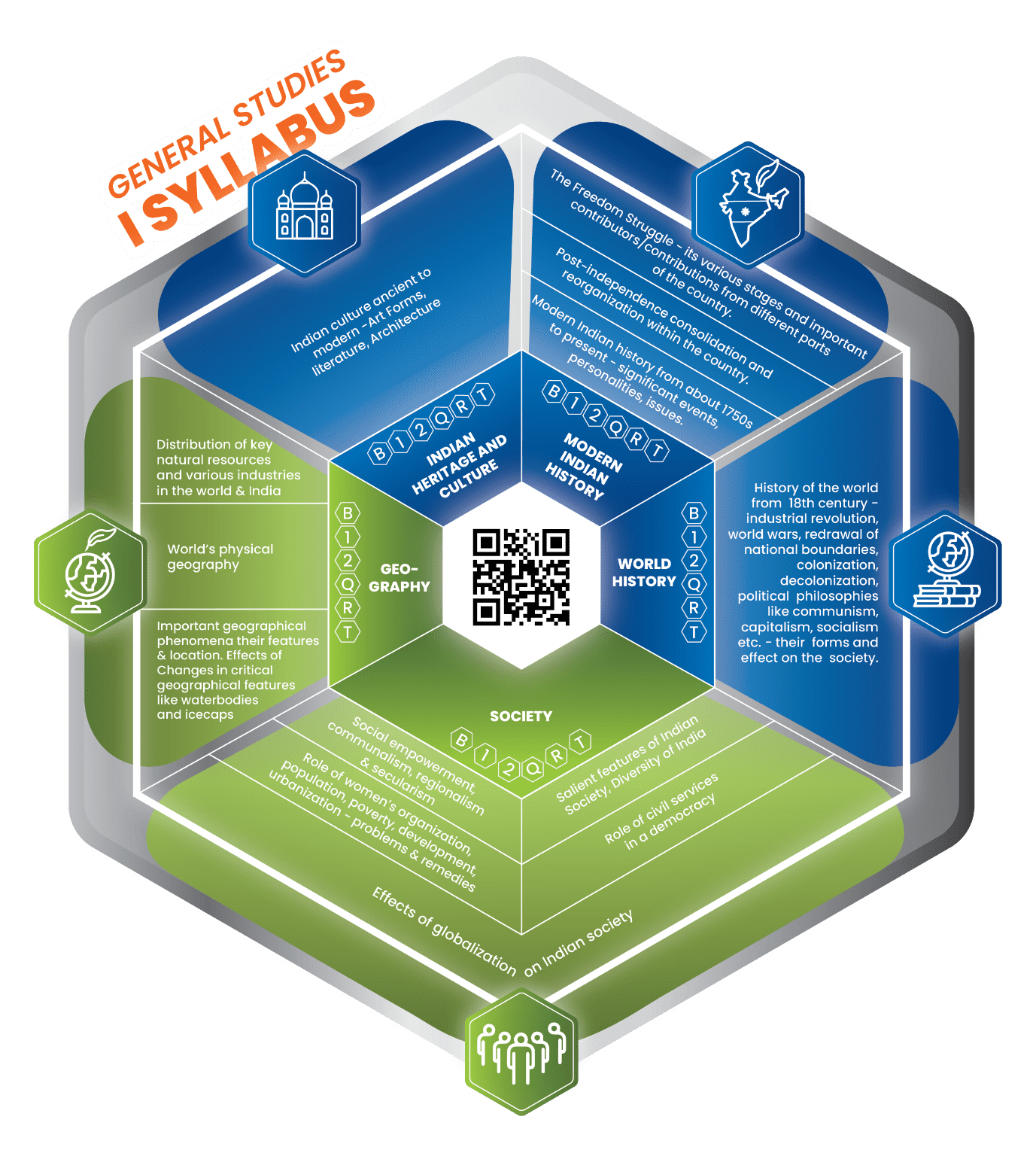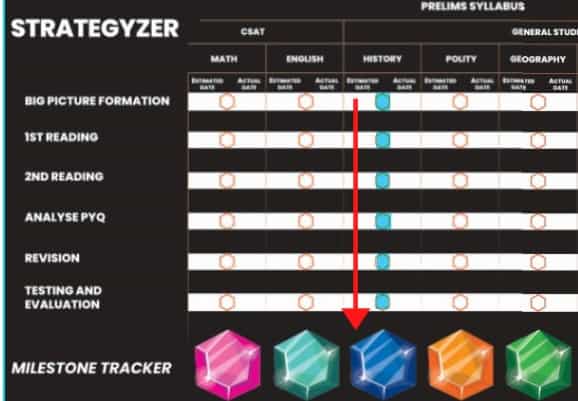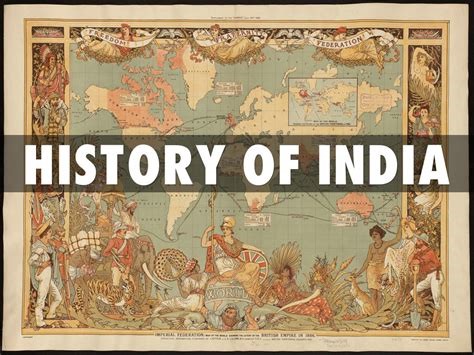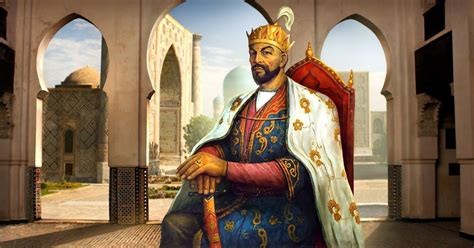
A serious UPSC aspirant should know that History for the UPSC exam is nothing like the history they read in school where you could get away with simple memorization.
This is a tragedy because History is so much more than names and dates.
History is a fascinating tale of human civilisation which is read and understood by studying what remains- records, manuscripts, artifacts, and monuments from a time long before you were born.
The story of history encompasses empires, kings, battles, lifestyles, cultures and everything else that our ancestors might have experienced as significant. Just like we experience smartphones, 9/11, Covid-19 and the Burj Khalifa. (This means we are creating history as we go, which begs the question- will our global civilization fall like all the great ones before? More importantly, will it be our own fault if it does?)
History is a fascinating tale of human civilization.
History is the systematic study of looking back in time for stories and lessons which are worth preserving for humanity- which is why we study Asoka the great and his principles of Good governance– an idea which informs our own policies to this day, more than 2000 years after the great emperor embraced compassion in the teachings of the Buddha. (Buddhism- another grand idea born in India).
A country like India- ancient, rich with kings, empires, culture, and big ideas has plenty worth preserving.
As a UPSC aspirant this should strike you as a fascinating thing- something to be curious about. And also, as an opportunity because it is probably the only time in your life you will have the luxury of time to learn these wonderful things.
This is the mindset with which you must approach History. This article contains everything else you need to know about preparing History for the UPSC exam- what to do, where to read from, how much time to do it in and how to know if you have done enough.
We are creating history as we go. So what will be the history of our future generations?
UPSC History Syllabus super-simplified
The syllabus of History in Prelims-
History of India and Indian National Movement.
The Syllabus of History in Mains
Excerpt from the official UPSC notification.
How best to organize this jumble of topics? There is the obvious categorization of History into Ancient, Medieval and Modern India but this does not cover all the topics (omits World History which is asked in Mains) nor does it allow you to cover Prelims and Mains together in an integrated way. (See Critical Insights in General Studies Super Simplified to understand the ideal approach to GS for UPSC).

The shape of the hexagons on the Ultimate UPSC Navigator contains some inherent insights about the UPSC exam. The embodied knowledge of the UPSC hexagons is Hexa-Gyan.
The Entire syllabus of History (Prelims and Mains combined) according to The Ultimate GS Taxonomy which takes into account all the critical insights of GS is to organize them in to the following 5 modules-
- History of the world
Events from 18th century which shaped the world
- Industrial revolution,
- world war 1 and 2
- Redrawal of national boundaries,
- Colonization,
- Decolonization,
- Political philosophies – their forms and effect on society.
i. communism,
ii. capitalism,
iii. socialism
II. Ancient India (Including Art & Culture)
- Rise and fall of Empires
- The birth and evolution of major religions and philosophies
- Government, Society, Economy and achievements
- Ancient Indian Art Forms,
- Ancient Indian literature
- Ancient Indian Architecture
III. Medieval India (Including Art & Culture)
- Rise and fall of Empires
- The birth and evolution of major religions and philosophies
- Government, Society, Economy, and achievements
- Medieval Indian salient aspects of Art Forms
- Medieval Indian literature
- Medieval Indian Architecture
IV. Modern India 1857- 1884
- Significant personalities
- Significant events
- Significant issues
V. Modern India 1884-1947(Indian Freedom Struggle)
- Significant events
- Significant issues
- Stages
- Important contributors
- Contributions from different parts of the country.
- Consolidation and reorganization within the country.
These 5 modules can be allocated roughly the same amount of time and investment. Only module 1 is not asked in Prelims (World history)- the rest are integrated for Prelims and Mains. They are theme-based but retain the broad structure of Ancient, Medieval and Modern. Using this taxonomy will ensure maximum efficiency in UPSC preparation for GS.
How best to use it is explained below.
THE ULTIMATE STRATEGY TO PREPARE HISTORY FOR UPSC: TOP5 PROTOCOL
If you want enough quality in your preparation to clear the cut-off, you must go through the Hexatask method for History.

Only after doing Big Picture formation, 1st reading, 2nd reading, analyzing PYQ, testing and Revision can you claim to have ‘done’ history for the UPSC exam. Use the Strategyzer to schedule and keep track of your progress as you do so.
Here’s what to do step by step
Big Picture Formation:
BPF (Big Picture Formation) should lay the groundwork of your core conceptual foundations for History. On this broad structure, you should overlay facts and more details in the other stages of the Hexatask method i.e., 1st Reading, 2nd Reading, Testing and so on.
For Indian History, Big Picture Formation would mean knowing the story of the Indian peninsula, the civilizations and cultures which prospered there, from the Indus valley to the British Raj, and how they all ultimately declined and merged into one composite nation. It is a fascinating tale, and you should treat it as such while preparing.
Here is the Ultimate Playlist of BPF for History curated and selected for you-
1st Reading
Do not try to create detailed notes during 1st Reading but just get accustomed to the book, its contents, and how they are scattered around the book. Try to grasp the narrative in more detail and take a mental picture of the textbook while you connect it with the fascinating facets you discovered during Big Picture Formation.
Instructions: This should be a deliberate but cursory reading which be finished in 1-3 weeks. If you think you need more time, you are probably reading too deeply and need to zoom out. If you finish the entire list above in less than 1 week, you read too fast and should revisit the contents and this time, read at half the speed.
2nd Reading for History
The 2nd reading task is when you do very detailed readings. Most aspirants jump to the 2nd reading stage without undergoing the two essential stages above and end up feeling overwhelmed because they expect a level of learning which can only be achieved by first establishing a strong conceptual foundation of the content.
Instructions: The 2nd Reading should be a slow, deliberate, and careful reading where you pay attention to detail, facts, exercises, names, events, etc. It may include multiple readings depending on your level of retention of the content. Which is why it deserves the maximum amount of time (4-6 weeks).
Analyze PYQ:
Here are the PYQ for History for Both Prelims and Mains
| 2020 | 2019 | 2018 | 2017 |
| 2016 | 2015 | 2014 | 2013 |
| 2012 | 2011 |
Revision:
Revision is where you memorize important details which you might have missed by using mnemonic techniques or repetition. It is a quicker version of the 1st and 2nd Reading. It is while doing revision that you re-read your sidenotes, notes, and symbols and recreate the content in your mind without having to read the entire book again.
By the time you approach revision, your content should be so condensed that you are able to review and revise entire chapters by merely glancing. Revision is not meant to learn new content but to condense and cement previously learned content.
Revision should be allocated 1-2 weeks. It is recommended to do multiple revisions. In fact, multiple revisions are usually required so while allocating time, make sure you keep a margin of time for repeated rehearsals.
Testing:
Testing should be a continuous process and serves as a critical feedback mechanism. You should test yourself on every subject when you wish to claim that it is done. In other words, when you have done at least 4 of the previous steps of the HEXATASK method (Big Picture Formation, 1st Reading, 2Nd Reading and PYQs. Testing too soon will lead to discouragement. Do not wait for the examination to draw near instead, schedule your tests using the UPSC Strategyzer. For history, at least 2 mock tests before Prelims and 2 before Mains are recommended.








